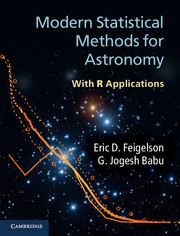Book contents
- Frontmatter
- Contents
- Preface
- 1 Introduction
- 2 Probability
- 3 Statistical inference
- 4 Probability distribution functions
- 5 Nonparametric statistics
- 6 Data smoothing: density estimation
- 7 Regression
- 8 Multivariate analysis
- 9 Clustering, classification and data mining
- 10 Nondetections: censored and truncated data
- 11 Time series analysis
- 12 Spatial point processes
- Appendix A Notation and acronyms
- Appendix B Getting started with R
- Appendix C Astronomical datasets
- References
- Subject index
- R and CRAN commands
- Plate section
5 - Nonparametric statistics
Published online by Cambridge University Press: 05 November 2012
- Frontmatter
- Contents
- Preface
- 1 Introduction
- 2 Probability
- 3 Statistical inference
- 4 Probability distribution functions
- 5 Nonparametric statistics
- 6 Data smoothing: density estimation
- 7 Regression
- 8 Multivariate analysis
- 9 Clustering, classification and data mining
- 10 Nondetections: censored and truncated data
- 11 Time series analysis
- 12 Spatial point processes
- Appendix A Notation and acronyms
- Appendix B Getting started with R
- Appendix C Astronomical datasets
- References
- Subject index
- R and CRAN commands
- Plate section
Summary
The astronomical context
Our astronomical knowledge of planets, stars, the interstellarmedium, galaxies or accretion phenomena is usually limited to a few observables that give limited information about the underlying conditions. Our astrophysical understanding usually involves primitive models of complex processes operating on complex distributions of atoms. In light of these diffi- culties intrinsic to astronomy, there is often little basis for assuming particular statistical distributions of and relationships between the observed variables. For example, astronomers frequently take the log of an observed variable to reduce broad ranges and to remove physical units, and then assume with little justification that their residuals around some distribution are normally distributed. Few astrophysical theories can predict whether the scatter in observable quantities is Gaussian in linear, logarithmic or other transformation of the variable.
Astronomersmay commonly use a simple heuristic model in situationswhere there is little astrophysical foundation, or where the underlying phenomena are undoubtedly far more complex. Linear or loglinear (i.e. power-law) fits are often used to quantify relationships between observables in starburst galaxies, molecular clouds or gamma-ray bursts where the statistical model has little basis in astrophysical theory. In such cases, the mathematical assumptions of the statistical procedures are often not established, and the choice of a simplistic model may obfuscate interesting characteristics of the data.
Feigelson (2007) reviews one of these situations where hundreds of studies over seven decades modeled the radial starlight profiles of elliptical galaxies using simple parametric models, see king to understand the distribution of mass within the galaxies.
- Type
- Chapter
- Information
- Modern Statistical Methods for AstronomyWith R Applications, pp. 105 - 127Publisher: Cambridge University PressPrint publication year: 2012

